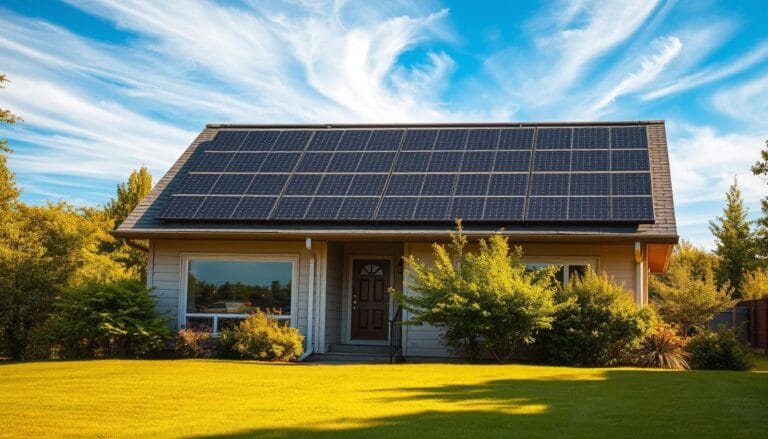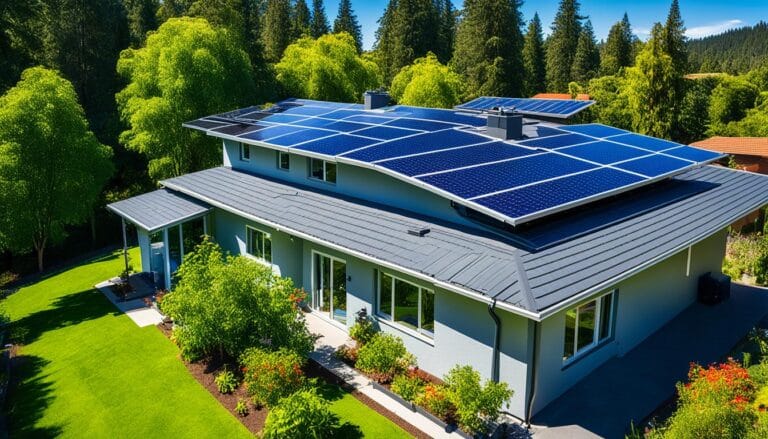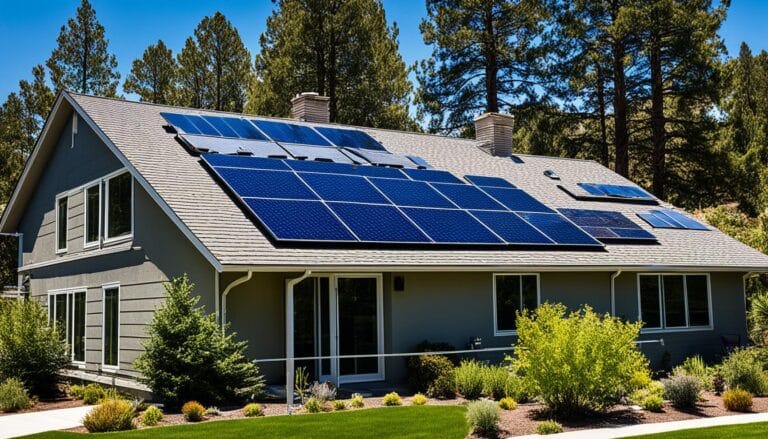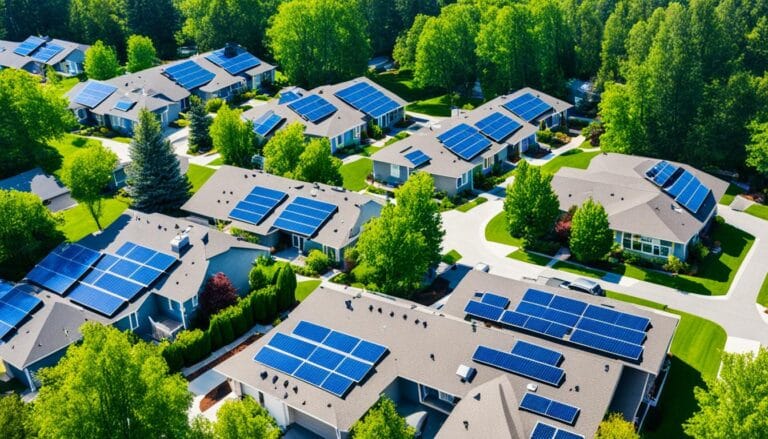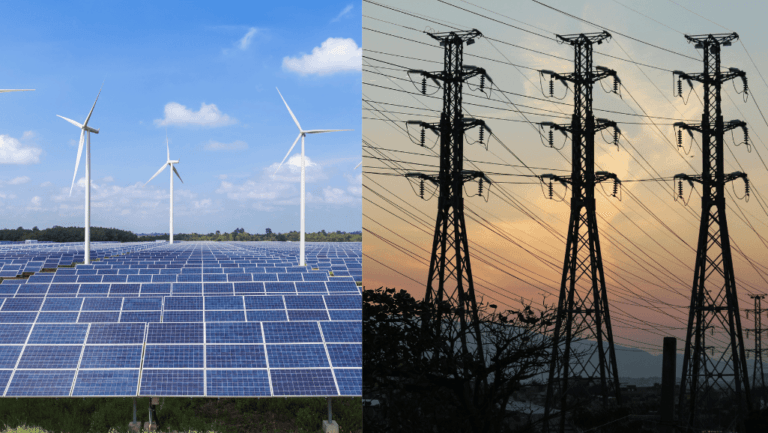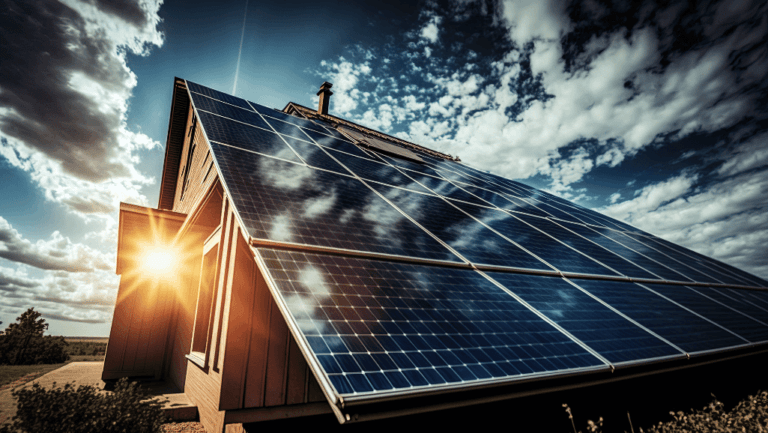Learn about the amazing savings from the federal solar tax credit. This incentive helps homeowners switch to clean energy. By getting solar panels, you cut down on carbon emissions and get big tax breaks. With a 30% tax credit for systems from 2022-2032, now is the perfect time to use the sun’s power and change your home’s energy use.
The government backs renewable energy with great solar incentives for homeowners. Claiming the residential solar tax credit lets you deduct a big part of your solar setup costs from your taxes. This credit covers solar panels, labor, and equipment, helping families switch to clean energy affordably.
Getting into solar panel tax rebates and clean energy tax benefits might seem tough, but we’re here to help. We’ll guide you through everything from checking if you’re eligible to figuring out your tax credit. With our help, you can confidently claim your solar installation tax deductions and enjoy the benefits of these government programs.
Key Takeaways
- The federal solar tax credit offers significant savings on home solar panel installations
- Homeowners can claim a 30% tax credit for systems installed between 2022-2032
- Eligible expenses include solar panels, labor, and equipment costs
- Claiming the solar tax credit can substantially reduce the cost of going solar
- Proper guidance ensures homeowners maximize their savings and benefits from government solar initiatives
Understanding the Federal Solar Tax Credit
The federal solar tax credit, also known as the solar investment tax credit or residential renewable energy tax credit, is a big help for homeowners and businesses. It encourages them to use solar energy. This federal solar panel incentive lets you claim a big part of your solar system costs as a tax credit. This makes switching to clean energy cheaper and easier.
What is the Federal Solar Tax Credit?
The federal solar tax credit, or ITC for solar systems, cuts your federal income tax bill by the amount you spend on solar energy. If your solar system costs $20,000, you can deduct $6,000 from your taxes. This means you save a lot of money.
On average, homeowners who claim the solar tax credit save an additional $9,716 on their solar costs.
This tax credit has no limit. Whether you have a small system at home or a big one for a business, you can claim the full 30% credit. It’s open to both homeowners and businesses. This solar energy tax rebate helps you cut down on energy costs and your carbon footprint.
How the Solar Tax Credit Works
To get the federal solar tax credit, you need to install a solar energy system on your property. This includes solar panels, inverters, and other equipment. After it’s installed and working, you can claim the credit when you file your taxes.
| Solar System Cost | Federal Tax Credit (30%) | Total Cost After Credit |
|---|---|---|
| $15,000 | $4,500 | $10,500 |
| $20,000 | $6,000 | $14,000 |
| $30,000 | $9,000 | $21,000 |
The solar tax credit is a non-refundable credit. It can only reduce your tax bill to zero. If your credit is more than your tax bill, you can carry over the extra to the next year.
Understanding the federal solar tax credit and using it can greatly lower the cost of solar energy. It also helps you save money on your energy bills for years to come. Start using the sun’s power and join the movement towards a cleaner future with this tax credit.
Eligibility for the Federal Solar Tax Credit
Homeowners in the United States can enjoy a big tax break for installing solar panels. This federal solar energy credit helps make clean energy more affordable. By meeting certain criteria, you can save a lot on your solar setup.
Requirements for Claiming the Solar Tax Credit
Your solar panel system must be up and running by December 31, 2034, to get the tax credit. It should be at your main or second home in the U.S., or part of a community solar project. You must own the system, either by paying cash or financing it. Leased systems don’t qualify for this tax break.
The system must be new or used for the first time. You can only claim the tax deduction for the initial setup. This ensures you get the most benefit from your investment.
Types of Qualifying Solar Systems
Many solar energy systems qualify for the tax credit, giving homeowners options. These include:
- Photovoltaic (PV) solar panel systems
- Solar water heating systems
- Solar-powered fuel cells
- Solar-powered water pumps
Not just rooftop systems, but ground-mounted and community solar projects can also qualify. This means homeowners can get the tax break even with limited space or unique property needs.
By meeting these requirements and choosing the right solar systems, homeowners can lower their taxes and save on energy bills. Start using solar energy and get your renewable energy tax incentive now.
Federal Solar Tax Credit Rates and Timelines
The federal solar tax credit, also known as the Investment Tax Credit (ITC), has boosted the solar industry in the U.S. It gives a big push for homeowners and businesses to go solar. This tax credit helps cut down on fossil fuel use and supports renewable energy.
Current and Future Tax Credit Percentages
The solar ITC offers a big tax break for installing solar panels. As of 2022, homeowners and businesses get 30% back on their solar panel costs. This means a 30% reduction in the cost of solar installations, making it more affordable.
This 30% rate will stay until 2032, giving a steady incentive for solar projects. But, the credit will decrease over time:
- 2033: The solar tax credit will drop to 26%
- 2034: It will go down to 22%
- 2035: The home credit ends, and the business credit falls to 10%
Deadlines for Installing Solar Panels
To get the full 30% tax credit, know the deadlines for solar panel installation. Systems must be installed and working from 2022 to 2032 to qualify for the full 30% credit. If installed in 2033, the credit drops to 26%, and in 2034, it’s 22%.
The solar tax break depends on when the system starts working, not when the contract is signed or installation begins. To get the most from the ITC, plan ahead and make sure the system is ready within the time limits.
| Year | Residential Solar Tax Credit | Commercial Solar Tax Credit |
|---|---|---|
| 2022-2032 | 30% | 30% |
| 2033 | 26% | 26% |
| 2034 | 22% | 22% |
| 2035 onwards | 0% | 10% |
Using the federal solar tax credit within these timelines helps homeowners and businesses save on solar costs. It also supports clean energy, saving money and fighting climate change. This tax exemption is a big step towards a sustainable future.
Qualifying Expenses for the Solar Tax Credit
When thinking about solar panels, it’s key to know what costs qualify for the federal solar tax credit. This knowledge helps you get the most from this financial boost.
Solar Panels and Equipment Costs
The solar tax credit covers many costs linked to your solar panel setup. These include:
- Solar panels and photovoltaic cells
- Inverters
- Racking and mounting systems
- Wiring and electrical components
- Battery storage devices (with a capacity of 3 kWh or greater for systems installed after December 31, 2022)
Adding these costs to your tax credit can cut down the cost of your solar system. This way, you enjoy the perks of green energy tax credits.
Labor and Installation Expenses
The credit also covers labor and setup costs. This includes:
- Contractor labor for preparation, assembly, and installation
- Permitting fees
- Inspection costs
- Developer fees
This makes solar panels more reachable for homeowners everywhere. It highlights the value of professional setup and related costs.
Energy Storage Devices
For systems put in place after December 31, 2022, the credit also covers energy storage costs. This includes batteries with a 3 kWh capacity or more. This move encourages homeowners to invest in storing solar energy. This is useful for times when the sun isn’t shining or during power cuts.
| Qualifying Expense | Description |
|---|---|
| Solar Panels | Photovoltaic panels and cells that turn sunlight into electricity |
| Inverters | Devices that change DC electricity from solar panels into AC for home use |
| Racking and Mounting | Systems that hold solar panels on your roof or ground |
| Wiring and Electrical Components | Wiring, junction boxes, and other parts needed for a working solar system |
| Battery Storage Devices | Energy storage solutions with a capacity of 3 kWh or greater (for systems installed after December 31, 2022) |
| Labor Costs | Contractor fees for setup, assembly, and installation |
| Permitting and Inspection Fees | Costs for permits and inspections needed for your solar system |
Knowing what expenses qualify for the solar tax credit helps you make smart choices for your solar setup. This way, you can fully benefit from solar panel tax deductions and green energy tax credits.
Claiming the Federal Solar Tax Credit
Using the sun’s power cuts down on carbon emissions and brings big solar installation tax benefits. Claiming the federal solar tax credit can lower your taxes and make going green more rewarding.
To get your solar panel tax credits, just follow a few easy steps. First, check if you qualify for residential solar tax incentives. You need a solar system on your main or second home in the U.S.
Then, fill out IRS Form 5695 for green energy tax deductions. This form lets you figure out your solar system’s total cost. Add up the cost of the equipment, permits, and labor. Then, multiply that by the tax credit percentage for the year you installed your system.
| Installation Year | Tax Credit Percentage |
|---|---|
| 2022-2032 | 30% |
| 2033 | 26% |
| 2034 | 22% |
After figuring out your solar energy tax rebates, move the info to Schedule 3 and Form 1040 when you file taxes. This credit will cut down your taxes, saving you thousands of dollars.
The average cost to install solar panels is between $20,000 and $30,000. With the 30% federal tax credit, you could save up to $9,000 on taxes.
If your taxes are less than your solar tax credit, don’t worry. You can carry over the extra credit to future years. This way, you make the most of your solar installation tax benefits. There’s no limit on who can get this credit if you put solar panels on your home.
Start using the sun’s power and claim your federal solar tax credit now. You’ll help make the planet greener and save money for choosing to be eco-friendly.
Calculating Your Solar Tax Credit Savings
The federal solar investment tax credit helps homeowners who choose solar energy. It’s a big financial boost. By knowing how to calculate your savings, you can decide if solar is right for you. This way, you can enjoy the perks of clean energy tax incentives.
Examples of Solar Tax Credit Amounts
Let’s look at some examples to see how the federal solar tax credit works. If your solar PV system costs $20,000 in 2023, you get a $6,000 tax credit (30% of $20,000). For a bigger project, like a solar and battery system costing $75,000, your tax credit could be $22,500.
| Solar System Cost | Federal Solar Tax Credit (30%) |
|---|---|
| $10,000 | $3,000 |
| $20,000 | $6,000 |
| $50,000 | $15,000 |
| $75,000 | $22,500 |
These examples show how the federal solar tax credit can save you a lot. It makes solar energy more affordable for homeowners everywhere.
Carrying Over Unused Tax Credits
Sometimes, the solar tax credit might be more than your taxes for the year. Luckily, you can carry over any extra credit to future years. For example, if your credit is $6,000 but your taxes are only $4,000, you can use the extra $2,000 the next year.
According to the Tax Foundation, the average federal income tax in the U.S. is $14,279 per year. So for a 6 kW solar system worth $17,100, a homeowner would see their income tax reduce to $9,149. They would also get the full $5,130 solar tax credit in the first year.
Using the federal solar tax credit and calculating your savings can make solar energy more affordable. This way, you can enjoy the benefits of clean, renewable energy for years to come.
Combining Federal and State Solar Incentives
You can save more on solar panel costs by using the federal solar tax credit with state incentives. Many states give extra solar energy tax deductions, rebates, and grants. These can cut the cost of solar power by a lot. By using these incentives together, homeowners can save a lot and get back their investment faster.
State Solar Tax Credits
Some states have their own solar tax credits you can add to the federal one. For example, Arizona gives a 25% tax credit, up to $1,000. New York offers a 25% credit, up to $5,000. Massachusetts and Maryland also let you combine their credits with the federal one, saving you more on solar costs.
Solar Rebates and Grants
States also offer solar rebates and grants to encourage solar use. These can lower the initial cost of solar panels. In California, the CSI program gives rebates based on system size and performance. Rebate amounts vary by utility and decrease as more solar is installed.
The DAC-SASH program in California gives $3 per watt of solar capacity ($3,000 per kilowatt) to low-income homeowners. It aims to make solar affordable for disadvantaged communities, with a budget of $8.5 million a year.
| State | Solar Incentive | Details |
|---|---|---|
| California | DAC-SASH Program | $3 per watt incentive for low-income homeowners |
| California | Self-Generation Incentive Program (SGIP) | Rebates for energy storage systems ranging from $0.15 to $0.85 per watt-hour |
| California | Property Tax Exclusion | Solar energy systems installed before 2025 are exempt from property tax increases |
| Arizona | Solar Tax Credit | 25% of system cost, up to $1,000 |
| New York | Solar State Tax Credit | 25% of system cost, up to $5,000 |
Using the federal solar tax credit with state incentives can greatly reduce the cost of solar installations. For instance, a California homeowner with a 5 kW system at $15,000 could get a $4,500 federal credit and a $3,000 DAC-SASH incentive. This would lower the total cost to $7,500, saving 50%.
Going solar not only helps homeowners save money but also makes our communities and planet greener.
With federal and state solar incentives, now is a great time to invest in solar for your home. Take advantage of these green energy tax incentives and sustainable energy tax rebates. This will help you save money, cut your carbon footprint, and use less fossil fuel.
Impact of Utility Rebates and Incentives on the Federal Solar Tax Credit
When thinking about the costs of solar panels, it’s key to know how utility rebates and incentives work with the federal solar tax credit. Many states and local companies offer solar energy incentives like rebates and grants. These can lower the cost of solar installations a lot.
But, remember that these rebates can affect your federal solar tax credit. Federal law says that rebates from your utility company for solar systems don’t count towards income taxes. So, when figuring out your federal solar tax credit, subtract the rebate from the cost first, then apply the tax credit percentage.
For instance, imagine you put in an 8 kW solar system in Texas in 2022 for $20,080. With a $2,500 rebate from your utility, your federal solar tax credit would be:
($20,080 – $2,500) * 0.30 = $5,274
Your federal solar tax credit would be $5,274, not $6,024 without the rebate. Even with this cut, combining residential solar tax benefits with utility incentives can still save you a lot on solar costs.
Make sure to check out the clean energy tax policies and incentives in your area, as they change a lot. Some big rebates and incentives in Texas include:
- American Electric Power: Solar installation rebate from $500 (for a 1kW system) to $3,000 (for systems over 7.5 kW)
- Austin Energy: Residential energy rebate of $2,500 for solar panel setups
- CPS Energy: Solar water heater rebate of 60 cents per kilowatt-hour of savings, up to $2,000
- Denton Municipal Electric: Solar photovoltaic incentive from $2,400 to $30,000 for solar panel setups
- Sunsets Valley: Solar Rebate Program offering $1 per watt of capacity up to $3,000 for residents with Austin Energy service
Using these green energy tax breaks and incentives, along with the federal solar tax credit, can make solar much cheaper for homes and businesses. Always talk to a tax expert to make sure you’re getting the most savings and handling rebates right when you claim your federal solar tax credit.
| Utility Company | Rebate/Incentive | Maximum Amount |
|---|---|---|
| American Electric Power | $500 – $3,000 (based on system size) | $3,000 |
| Austin Energy | $2,500 flat rebate | $2,500 |
| CPS Energy | 60 cents per kWh of annual savings | $2,000 |
| Denton Municipal Electric | $2,400 – $30,000 (based on system size) | $30,000 |
| Sunsets Valley | $1 per watt of capacity | $3,000 |
Federal Solar Tax Credit for Rental Properties and Second Homes
Homeowners can get big tax breaks for solar energy systems. This includes primary homes, rental properties, and second homes. Knowing how to apply can help you save a lot on your solar system.
Eligibility for Rental Properties
If you own a rental property and live there part-time, you might get the solar tax credit. The credit amount depends on how much you live there. For example, if you live at your rental for half the year and install a $20,000 system, you get a $3,000 credit.
To get the solar tax credit for a rental, you must:
- The property must be in the United States
- You must live there part of the year
- The solar system must be installed during the tax year
- The system must power the rental property
Claiming the Credit for Second Homes
Second home owners can also get the solar tax credit if their property is in the U.S. and not rented. This includes vacation homes and cabins. It’s a great way to cut energy costs and reduce your carbon footprint.
Remember these points when claiming the credit for a second home:
- The second home must be your residence
- The solar system must be on the home’s roof or land
- You can claim the full cost of the system, including labor and installation
- Any unused credit can be carried over to future years
| Property Type | Eligibility for Federal Solar Tax Credit |
|---|---|
| Primary Residence | Eligible for full credit |
| Rental Property (Partial Occupancy) | Eligible for prorated credit based on occupancy time |
| Second Home (Not Rented) | Eligible for full credit |
| Investment Property (Fully Rented) | Not eligible for residential credit, but may qualify for business credit |
Using the solar tax credit for rental and second homes can greatly lower your solar system costs. Talk to a tax expert to make sure you follow all rules and claim your benefits right. This way, you can save more on your solar setup.
The Importance of Professional Tax Advice
Going solar for your home is a big step that can save you money, thanks to the federal solar tax credit. But, understanding tax laws and getting the most from your solar setup can be tough. That’s why getting professional tax advice is key.
Consulting with a Tax Professional
Working with a tax pro who knows about solar energy can really help you out. They keep up with tax law changes and give advice just for you. They’ll help you see if you’re eligible, figure out your savings, and spot more state or local perks.
They also make sure you document your solar costs right and file your taxes correctly. They help you claim everything you can, like equipment, labor, and permits. With a tax expert, you’ll know your solar tax filing is right and you’re getting all the benefits you should.
Ensuring Proper Documentation
Having the right documents is crucial for the solar tax credit. Your solar installer should give you a detailed bill for your system, including all costs. Keep all your papers, like invoices and contracts, in a safe spot for taxes.
You might also need to show proof of payment, like bank statements or credit card receipts. Your tax pro will tell you what you need and help you collect everything for your tax claim.
With the right documents and tax advice, you can confidently claim your solar tax credit. Their help prevents mistakes, boosts your savings, and makes your solar investment pay off in the long run.
The Future of the Federal Solar Tax Credit
The solar industry is growing fast, and many are watching the future of the federal solar tax credit closely. This credit has made solar energy more affordable and accessible in the U.S. With the current schedule ending in 2035, people wonder what’s next for this important policy.
Groups in the solar industry and environmental supporters are pushing for a solar tax credit extension. They believe it will support clean energy growth, help meet climate goals, and boost jobs and the economy. But, Congress will decide its future.
Potential Extensions and Changes
The solar tax credit is set to decrease and end in 2035, but there could be changes. Here are some possible scenarios:
- Extension of the 30% tax credit beyond 2032
- Gradual step-down of the credit percentage over a longer period
- Expansion of the credit to include additional clean energy technologies
- Increased focus on low-income and underserved communities
Any changes to the solar tax credit need Congressional approval. Advocates are working hard to get support for long-term benefits. They highlight the economic and environmental benefits of a strong solar industry.
| Year | Solar Tax Credit Percentage |
|---|---|
| 2022-2032 | 30% |
| 2033 | 26% |
| 2034 | 22% |
| 2035 and beyond | 0% (expires) |
The table shows the current solar tax credit schedule is a big incentive to go solar now. Installing solar before 2032 lets you claim a full 30% tax credit, saving thousands.
Solar advocates are hopeful about the future. With the Biden administration focusing on climate change and clean energy, they think solar policy changes are coming. As more Americans see the benefits of solar power, demand for incentives will grow.
“The solar industry has proven its resilience and adaptability time and time again. We are confident that, with the right policies in place, solar energy will play a crucial role in building a cleaner, more sustainable future for all.” – Jane Smith, SolarTech CEO
The federal solar tax credit will continue to be key for the solar industry’s growth and success. By keeping up with potential changes, homeowners and businesses can make smart solar investment decisions.
Conclusion
The federal solar tax credit is a great chance for homeowners and businesses to go solar. It lets you deduct 30% of your solar setup costs from your taxes. This makes going solar with tax incentives easier and cheaper.
When you add state and local incentives like rebates and grants, solar becomes even more attractive. These incentives make the financial benefits of solar more appealing.
Looking into the benefits of solar energy shows its long-term perks. You’ll see lower energy bills and a smaller carbon footprint. Plus, you’ll help make the planet cleaner for the future.
The federal solar tax credit will decrease soon, making now a great time to switch to affordable solar with tax credits.
To get the most out of solar energy savings, talk to a professional. They can help you understand the process and find all the incentives you can get. With the right guidance, you can cut the cost of solar installation and enjoy clean energy for years.
By choosing solar, you join a community that’s making a difference. You’ll save on energy bills and help the environment. Start using solar power today and make a positive change.
FAQ
What is the federal solar tax credit?
How do I qualify for the federal solar tax credit?
What expenses are included in the federal solar tax credit?
How do I claim the federal solar tax credit?
Can I combine the federal solar tax credit with state incentives?
How do utility rebates impact the federal solar tax credit?
What is the federal solar tax credit?
How do I qualify for the federal solar tax credit?
What expenses are included in the federal solar tax credit?
How do I claim the federal solar tax credit?
Can I combine the federal solar tax credit with state incentives?
How do utility rebates impact the federal solar tax credit?
FAQ
What is the federal solar tax credit?
The federal solar tax credit, also known as the Investment Tax Credit (ITC), lets you deduct 30% of your solar system’s cost from your taxes. This means a direct reduction in the taxes you owe.
How do I qualify for the federal solar tax credit?
To get the federal solar tax credit, your system must be installed by December 31, 2034. It should be at your main or second home in the U.S. You must own the system, either by paying cash or financing it. The system must be new and used for the first time.
What expenses are included in the federal solar tax credit?
The credit covers costs like solar PV panels or PV cells, labor for setup and installation, and balance-of-system equipment. It also includes energy storage devices with a capacity of 3 kWh or more (for systems installed after December 31, 2022), and sales taxes on eligible costs.
How do I claim the federal solar tax credit?
Claim the credit by filing IRS Form 5695 with your tax return. First, add up your qualified solar costs. Then, multiply that by the tax credit percentage (30% for 2022-2032, 26% for 2033, and 22% for 2034).
Can I combine the federal solar tax credit with state incentives?
Yes, you can combine the federal credit with state and local incentives. Many states offer extra credits, rebates, and grants to help lower the cost of solar.
How do utility rebates impact the federal solar tax credit?
Utility rebates reduce your system costs before you calculate the federal tax credit. For example, if your system costs ,000 and you got a
FAQ
What is the federal solar tax credit?
The federal solar tax credit, also known as the Investment Tax Credit (ITC), lets you deduct 30% of your solar system’s cost from your taxes. This means a direct reduction in the taxes you owe.
How do I qualify for the federal solar tax credit?
To get the federal solar tax credit, your system must be installed by December 31, 2034. It should be at your main or second home in the U.S. You must own the system, either by paying cash or financing it. The system must be new and used for the first time.
What expenses are included in the federal solar tax credit?
The credit covers costs like solar PV panels or PV cells, labor for setup and installation, and balance-of-system equipment. It also includes energy storage devices with a capacity of 3 kWh or more (for systems installed after December 31, 2022), and sales taxes on eligible costs.
How do I claim the federal solar tax credit?
Claim the credit by filing IRS Form 5695 with your tax return. First, add up your qualified solar costs. Then, multiply that by the tax credit percentage (30% for 2022-2032, 26% for 2033, and 22% for 2034).
Can I combine the federal solar tax credit with state incentives?
Yes, you can combine the federal credit with state and local incentives. Many states offer extra credits, rebates, and grants to help lower the cost of solar.
How do utility rebates impact the federal solar tax credit?
Utility rebates reduce your system costs before you calculate the federal tax credit. For example, if your system costs $18,000 and you got a $1,000 rebate, your credit would be ($18,000 – $1,000) * 0.30 = $5,100.
Can I claim the federal solar tax credit for a rental property or second home?
Yes, you can claim the credit for a rental property if you live there part-time. You’ll claim a portion of the credit based on how much you use it. For a second home, claim the full credit if it’s not rented out.
Should I consult a tax professional when claiming the federal solar tax credit?
While the credit is simple, getting advice from a tax expert is wise, especially if your taxes are complex. They can ensure you’re claiming the credit right and getting the most from your solar investment.
,000 rebate, your credit would be (,000 –
FAQ
What is the federal solar tax credit?
The federal solar tax credit, also known as the Investment Tax Credit (ITC), lets you deduct 30% of your solar system’s cost from your taxes. This means a direct reduction in the taxes you owe.
How do I qualify for the federal solar tax credit?
To get the federal solar tax credit, your system must be installed by December 31, 2034. It should be at your main or second home in the U.S. You must own the system, either by paying cash or financing it. The system must be new and used for the first time.
What expenses are included in the federal solar tax credit?
The credit covers costs like solar PV panels or PV cells, labor for setup and installation, and balance-of-system equipment. It also includes energy storage devices with a capacity of 3 kWh or more (for systems installed after December 31, 2022), and sales taxes on eligible costs.
How do I claim the federal solar tax credit?
Claim the credit by filing IRS Form 5695 with your tax return. First, add up your qualified solar costs. Then, multiply that by the tax credit percentage (30% for 2022-2032, 26% for 2033, and 22% for 2034).
Can I combine the federal solar tax credit with state incentives?
Yes, you can combine the federal credit with state and local incentives. Many states offer extra credits, rebates, and grants to help lower the cost of solar.
How do utility rebates impact the federal solar tax credit?
Utility rebates reduce your system costs before you calculate the federal tax credit. For example, if your system costs $18,000 and you got a $1,000 rebate, your credit would be ($18,000 – $1,000) * 0.30 = $5,100.
Can I claim the federal solar tax credit for a rental property or second home?
Yes, you can claim the credit for a rental property if you live there part-time. You’ll claim a portion of the credit based on how much you use it. For a second home, claim the full credit if it’s not rented out.
Should I consult a tax professional when claiming the federal solar tax credit?
While the credit is simple, getting advice from a tax expert is wise, especially if your taxes are complex. They can ensure you’re claiming the credit right and getting the most from your solar investment.
,000) * 0.30 = ,100.
Can I claim the federal solar tax credit for a rental property or second home?
Yes, you can claim the credit for a rental property if you live there part-time. You’ll claim a portion of the credit based on how much you use it. For a second home, claim the full credit if it’s not rented out.
Should I consult a tax professional when claiming the federal solar tax credit?
While the credit is simple, getting advice from a tax expert is wise, especially if your taxes are complex. They can ensure you’re claiming the credit right and getting the most from your solar investment.
FAQ
What is the federal solar tax credit?
The federal solar tax credit, also known as the Investment Tax Credit (ITC), lets you deduct 30% of your solar system’s cost from your taxes. This means a direct reduction in the taxes you owe.
How do I qualify for the federal solar tax credit?
To get the federal solar tax credit, your system must be installed by December 31, 2034. It should be at your main or second home in the U.S. You must own the system, either by paying cash or financing it. The system must be new and used for the first time.
What expenses are included in the federal solar tax credit?
The credit covers costs like solar PV panels or PV cells, labor for setup and installation, and balance-of-system equipment. It also includes energy storage devices with a capacity of 3 kWh or more (for systems installed after December 31, 2022), and sales taxes on eligible costs.
How do I claim the federal solar tax credit?
Claim the credit by filing IRS Form 5695 with your tax return. First, add up your qualified solar costs. Then, multiply that by the tax credit percentage (30% for 2022-2032, 26% for 2033, and 22% for 2034).
Can I combine the federal solar tax credit with state incentives?
Yes, you can combine the federal credit with state and local incentives. Many states offer extra credits, rebates, and grants to help lower the cost of solar.
How do utility rebates impact the federal solar tax credit?
Utility rebates reduce your system costs before you calculate the federal tax credit. For example, if your system costs ,000 and you got a
FAQ
What is the federal solar tax credit?
The federal solar tax credit, also known as the Investment Tax Credit (ITC), lets you deduct 30% of your solar system’s cost from your taxes. This means a direct reduction in the taxes you owe.
How do I qualify for the federal solar tax credit?
To get the federal solar tax credit, your system must be installed by December 31, 2034. It should be at your main or second home in the U.S. You must own the system, either by paying cash or financing it. The system must be new and used for the first time.
What expenses are included in the federal solar tax credit?
The credit covers costs like solar PV panels or PV cells, labor for setup and installation, and balance-of-system equipment. It also includes energy storage devices with a capacity of 3 kWh or more (for systems installed after December 31, 2022), and sales taxes on eligible costs.
How do I claim the federal solar tax credit?
Claim the credit by filing IRS Form 5695 with your tax return. First, add up your qualified solar costs. Then, multiply that by the tax credit percentage (30% for 2022-2032, 26% for 2033, and 22% for 2034).
Can I combine the federal solar tax credit with state incentives?
Yes, you can combine the federal credit with state and local incentives. Many states offer extra credits, rebates, and grants to help lower the cost of solar.
How do utility rebates impact the federal solar tax credit?
Utility rebates reduce your system costs before you calculate the federal tax credit. For example, if your system costs $18,000 and you got a $1,000 rebate, your credit would be ($18,000 – $1,000) * 0.30 = $5,100.
Can I claim the federal solar tax credit for a rental property or second home?
Yes, you can claim the credit for a rental property if you live there part-time. You’ll claim a portion of the credit based on how much you use it. For a second home, claim the full credit if it’s not rented out.
Should I consult a tax professional when claiming the federal solar tax credit?
While the credit is simple, getting advice from a tax expert is wise, especially if your taxes are complex. They can ensure you’re claiming the credit right and getting the most from your solar investment.
,000 rebate, your credit would be (,000 –
FAQ
What is the federal solar tax credit?
The federal solar tax credit, also known as the Investment Tax Credit (ITC), lets you deduct 30% of your solar system’s cost from your taxes. This means a direct reduction in the taxes you owe.
How do I qualify for the federal solar tax credit?
To get the federal solar tax credit, your system must be installed by December 31, 2034. It should be at your main or second home in the U.S. You must own the system, either by paying cash or financing it. The system must be new and used for the first time.
What expenses are included in the federal solar tax credit?
The credit covers costs like solar PV panels or PV cells, labor for setup and installation, and balance-of-system equipment. It also includes energy storage devices with a capacity of 3 kWh or more (for systems installed after December 31, 2022), and sales taxes on eligible costs.
How do I claim the federal solar tax credit?
Claim the credit by filing IRS Form 5695 with your tax return. First, add up your qualified solar costs. Then, multiply that by the tax credit percentage (30% for 2022-2032, 26% for 2033, and 22% for 2034).
Can I combine the federal solar tax credit with state incentives?
Yes, you can combine the federal credit with state and local incentives. Many states offer extra credits, rebates, and grants to help lower the cost of solar.
How do utility rebates impact the federal solar tax credit?
Utility rebates reduce your system costs before you calculate the federal tax credit. For example, if your system costs $18,000 and you got a $1,000 rebate, your credit would be ($18,000 – $1,000) * 0.30 = $5,100.
Can I claim the federal solar tax credit for a rental property or second home?
Yes, you can claim the credit for a rental property if you live there part-time. You’ll claim a portion of the credit based on how much you use it. For a second home, claim the full credit if it’s not rented out.
Should I consult a tax professional when claiming the federal solar tax credit?
While the credit is simple, getting advice from a tax expert is wise, especially if your taxes are complex. They can ensure you’re claiming the credit right and getting the most from your solar investment.
,000) * 0.30 = ,100.
Can I claim the federal solar tax credit for a rental property or second home?
Yes, you can claim the credit for a rental property if you live there part-time. You’ll claim a portion of the credit based on how much you use it. For a second home, claim the full credit if it’s not rented out.
Should I consult a tax professional when claiming the federal solar tax credit?
While the credit is simple, getting advice from a tax expert is wise, especially if your taxes are complex. They can ensure you’re claiming the credit right and getting the most from your solar investment.
Can I claim the federal solar tax credit for a rental property or second home?
Should I consult a tax professional when claiming the federal solar tax credit?
What is the federal solar tax credit?
How do I qualify for the federal solar tax credit?
What expenses are included in the federal solar tax credit?
How do I claim the federal solar tax credit?
Can I combine the federal solar tax credit with state incentives?
How do utility rebates impact the federal solar tax credit?
FAQ
What is the federal solar tax credit?
The federal solar tax credit, also known as the Investment Tax Credit (ITC), lets you deduct 30% of your solar system’s cost from your taxes. This means a direct reduction in the taxes you owe.
How do I qualify for the federal solar tax credit?
To get the federal solar tax credit, your system must be installed by December 31, 2034. It should be at your main or second home in the U.S. You must own the system, either by paying cash or financing it. The system must be new and used for the first time.
What expenses are included in the federal solar tax credit?
The credit covers costs like solar PV panels or PV cells, labor for setup and installation, and balance-of-system equipment. It also includes energy storage devices with a capacity of 3 kWh or more (for systems installed after December 31, 2022), and sales taxes on eligible costs.
How do I claim the federal solar tax credit?
Claim the credit by filing IRS Form 5695 with your tax return. First, add up your qualified solar costs. Then, multiply that by the tax credit percentage (30% for 2022-2032, 26% for 2033, and 22% for 2034).
Can I combine the federal solar tax credit with state incentives?
Yes, you can combine the federal credit with state and local incentives. Many states offer extra credits, rebates, and grants to help lower the cost of solar.
How do utility rebates impact the federal solar tax credit?
Utility rebates reduce your system costs before you calculate the federal tax credit. For example, if your system costs ,000 and you got a
FAQ
What is the federal solar tax credit?
The federal solar tax credit, also known as the Investment Tax Credit (ITC), lets you deduct 30% of your solar system’s cost from your taxes. This means a direct reduction in the taxes you owe.
How do I qualify for the federal solar tax credit?
To get the federal solar tax credit, your system must be installed by December 31, 2034. It should be at your main or second home in the U.S. You must own the system, either by paying cash or financing it. The system must be new and used for the first time.
What expenses are included in the federal solar tax credit?
The credit covers costs like solar PV panels or PV cells, labor for setup and installation, and balance-of-system equipment. It also includes energy storage devices with a capacity of 3 kWh or more (for systems installed after December 31, 2022), and sales taxes on eligible costs.
How do I claim the federal solar tax credit?
Claim the credit by filing IRS Form 5695 with your tax return. First, add up your qualified solar costs. Then, multiply that by the tax credit percentage (30% for 2022-2032, 26% for 2033, and 22% for 2034).
Can I combine the federal solar tax credit with state incentives?
Yes, you can combine the federal credit with state and local incentives. Many states offer extra credits, rebates, and grants to help lower the cost of solar.
How do utility rebates impact the federal solar tax credit?
Utility rebates reduce your system costs before you calculate the federal tax credit. For example, if your system costs $18,000 and you got a $1,000 rebate, your credit would be ($18,000 – $1,000) * 0.30 = $5,100.
Can I claim the federal solar tax credit for a rental property or second home?
Yes, you can claim the credit for a rental property if you live there part-time. You’ll claim a portion of the credit based on how much you use it. For a second home, claim the full credit if it’s not rented out.
Should I consult a tax professional when claiming the federal solar tax credit?
While the credit is simple, getting advice from a tax expert is wise, especially if your taxes are complex. They can ensure you’re claiming the credit right and getting the most from your solar investment.
,000 rebate, your credit would be (,000 –
FAQ
What is the federal solar tax credit?
The federal solar tax credit, also known as the Investment Tax Credit (ITC), lets you deduct 30% of your solar system’s cost from your taxes. This means a direct reduction in the taxes you owe.
How do I qualify for the federal solar tax credit?
To get the federal solar tax credit, your system must be installed by December 31, 2034. It should be at your main or second home in the U.S. You must own the system, either by paying cash or financing it. The system must be new and used for the first time.
What expenses are included in the federal solar tax credit?
The credit covers costs like solar PV panels or PV cells, labor for setup and installation, and balance-of-system equipment. It also includes energy storage devices with a capacity of 3 kWh or more (for systems installed after December 31, 2022), and sales taxes on eligible costs.
How do I claim the federal solar tax credit?
Claim the credit by filing IRS Form 5695 with your tax return. First, add up your qualified solar costs. Then, multiply that by the tax credit percentage (30% for 2022-2032, 26% for 2033, and 22% for 2034).
Can I combine the federal solar tax credit with state incentives?
Yes, you can combine the federal credit with state and local incentives. Many states offer extra credits, rebates, and grants to help lower the cost of solar.
How do utility rebates impact the federal solar tax credit?
Utility rebates reduce your system costs before you calculate the federal tax credit. For example, if your system costs $18,000 and you got a $1,000 rebate, your credit would be ($18,000 – $1,000) * 0.30 = $5,100.
Can I claim the federal solar tax credit for a rental property or second home?
Yes, you can claim the credit for a rental property if you live there part-time. You’ll claim a portion of the credit based on how much you use it. For a second home, claim the full credit if it’s not rented out.
Should I consult a tax professional when claiming the federal solar tax credit?
While the credit is simple, getting advice from a tax expert is wise, especially if your taxes are complex. They can ensure you’re claiming the credit right and getting the most from your solar investment.
,000) * 0.30 = ,100.
Can I claim the federal solar tax credit for a rental property or second home?
Yes, you can claim the credit for a rental property if you live there part-time. You’ll claim a portion of the credit based on how much you use it. For a second home, claim the full credit if it’s not rented out.
Should I consult a tax professional when claiming the federal solar tax credit?
While the credit is simple, getting advice from a tax expert is wise, especially if your taxes are complex. They can ensure you’re claiming the credit right and getting the most from your solar investment.
FAQ
What is the federal solar tax credit?
The federal solar tax credit, also known as the Investment Tax Credit (ITC), lets you deduct 30% of your solar system’s cost from your taxes. This means a direct reduction in the taxes you owe.
How do I qualify for the federal solar tax credit?
To get the federal solar tax credit, your system must be installed by December 31, 2034. It should be at your main or second home in the U.S. You must own the system, either by paying cash or financing it. The system must be new and used for the first time.
What expenses are included in the federal solar tax credit?
The credit covers costs like solar PV panels or PV cells, labor for setup and installation, and balance-of-system equipment. It also includes energy storage devices with a capacity of 3 kWh or more (for systems installed after December 31, 2022), and sales taxes on eligible costs.
How do I claim the federal solar tax credit?
Claim the credit by filing IRS Form 5695 with your tax return. First, add up your qualified solar costs. Then, multiply that by the tax credit percentage (30% for 2022-2032, 26% for 2033, and 22% for 2034).
Can I combine the federal solar tax credit with state incentives?
Yes, you can combine the federal credit with state and local incentives. Many states offer extra credits, rebates, and grants to help lower the cost of solar.
How do utility rebates impact the federal solar tax credit?
Utility rebates reduce your system costs before you calculate the federal tax credit. For example, if your system costs ,000 and you got a
FAQ
What is the federal solar tax credit?
The federal solar tax credit, also known as the Investment Tax Credit (ITC), lets you deduct 30% of your solar system’s cost from your taxes. This means a direct reduction in the taxes you owe.
How do I qualify for the federal solar tax credit?
To get the federal solar tax credit, your system must be installed by December 31, 2034. It should be at your main or second home in the U.S. You must own the system, either by paying cash or financing it. The system must be new and used for the first time.
What expenses are included in the federal solar tax credit?
The credit covers costs like solar PV panels or PV cells, labor for setup and installation, and balance-of-system equipment. It also includes energy storage devices with a capacity of 3 kWh or more (for systems installed after December 31, 2022), and sales taxes on eligible costs.
How do I claim the federal solar tax credit?
Claim the credit by filing IRS Form 5695 with your tax return. First, add up your qualified solar costs. Then, multiply that by the tax credit percentage (30% for 2022-2032, 26% for 2033, and 22% for 2034).
Can I combine the federal solar tax credit with state incentives?
Yes, you can combine the federal credit with state and local incentives. Many states offer extra credits, rebates, and grants to help lower the cost of solar.
How do utility rebates impact the federal solar tax credit?
Utility rebates reduce your system costs before you calculate the federal tax credit. For example, if your system costs $18,000 and you got a $1,000 rebate, your credit would be ($18,000 – $1,000) * 0.30 = $5,100.
Can I claim the federal solar tax credit for a rental property or second home?
Yes, you can claim the credit for a rental property if you live there part-time. You’ll claim a portion of the credit based on how much you use it. For a second home, claim the full credit if it’s not rented out.
Should I consult a tax professional when claiming the federal solar tax credit?
While the credit is simple, getting advice from a tax expert is wise, especially if your taxes are complex. They can ensure you’re claiming the credit right and getting the most from your solar investment.
,000 rebate, your credit would be (,000 –
FAQ
What is the federal solar tax credit?
The federal solar tax credit, also known as the Investment Tax Credit (ITC), lets you deduct 30% of your solar system’s cost from your taxes. This means a direct reduction in the taxes you owe.
How do I qualify for the federal solar tax credit?
To get the federal solar tax credit, your system must be installed by December 31, 2034. It should be at your main or second home in the U.S. You must own the system, either by paying cash or financing it. The system must be new and used for the first time.
What expenses are included in the federal solar tax credit?
The credit covers costs like solar PV panels or PV cells, labor for setup and installation, and balance-of-system equipment. It also includes energy storage devices with a capacity of 3 kWh or more (for systems installed after December 31, 2022), and sales taxes on eligible costs.
How do I claim the federal solar tax credit?
Claim the credit by filing IRS Form 5695 with your tax return. First, add up your qualified solar costs. Then, multiply that by the tax credit percentage (30% for 2022-2032, 26% for 2033, and 22% for 2034).
Can I combine the federal solar tax credit with state incentives?
Yes, you can combine the federal credit with state and local incentives. Many states offer extra credits, rebates, and grants to help lower the cost of solar.
How do utility rebates impact the federal solar tax credit?
Utility rebates reduce your system costs before you calculate the federal tax credit. For example, if your system costs $18,000 and you got a $1,000 rebate, your credit would be ($18,000 – $1,000) * 0.30 = $5,100.
Can I claim the federal solar tax credit for a rental property or second home?
Yes, you can claim the credit for a rental property if you live there part-time. You’ll claim a portion of the credit based on how much you use it. For a second home, claim the full credit if it’s not rented out.
Should I consult a tax professional when claiming the federal solar tax credit?
While the credit is simple, getting advice from a tax expert is wise, especially if your taxes are complex. They can ensure you’re claiming the credit right and getting the most from your solar investment.
,000) * 0.30 = ,100.
Can I claim the federal solar tax credit for a rental property or second home?
Yes, you can claim the credit for a rental property if you live there part-time. You’ll claim a portion of the credit based on how much you use it. For a second home, claim the full credit if it’s not rented out.
Should I consult a tax professional when claiming the federal solar tax credit?
While the credit is simple, getting advice from a tax expert is wise, especially if your taxes are complex. They can ensure you’re claiming the credit right and getting the most from your solar investment.







